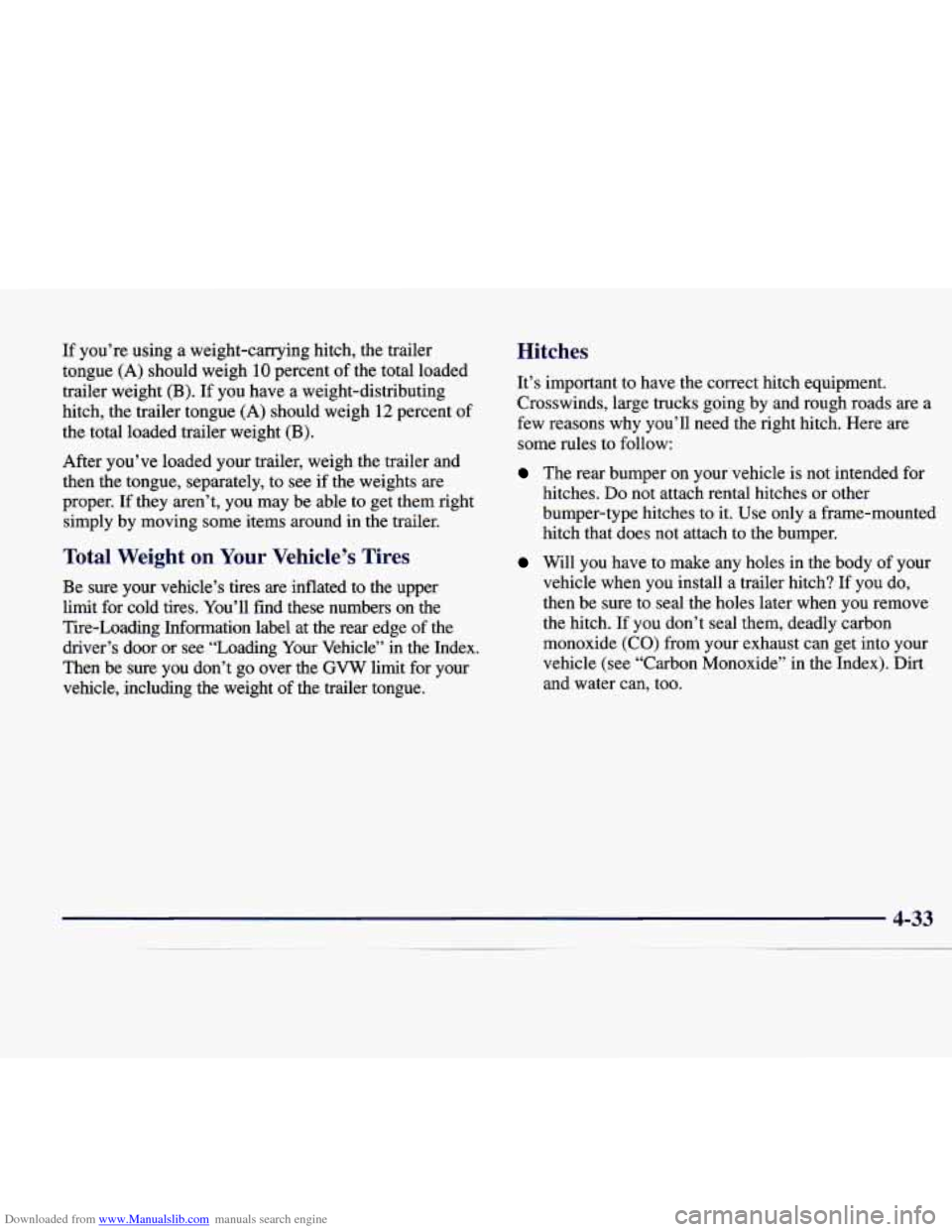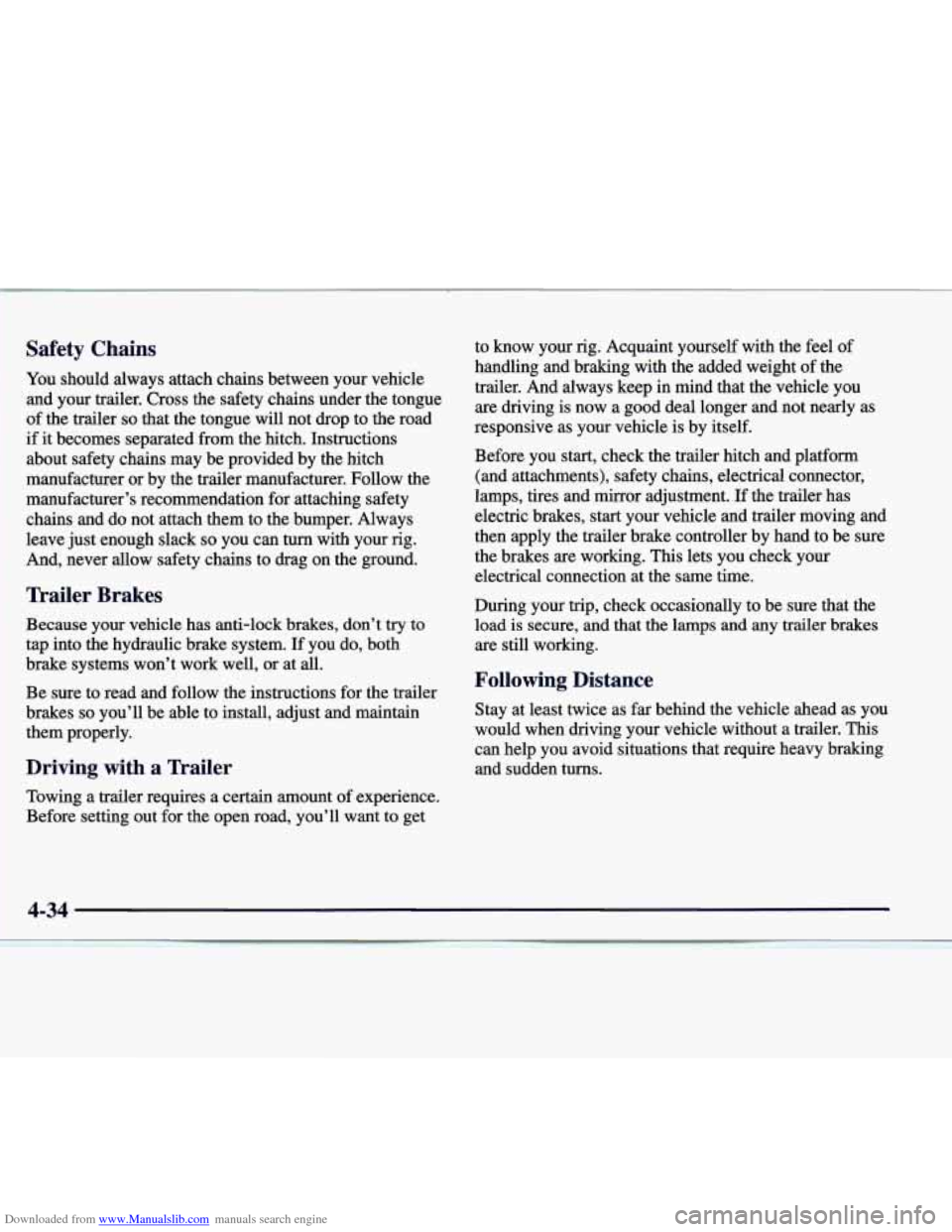1998 CADILLAC CATERA weight
[x] Cancel search: weightPage 210 of 346

Downloaded from www.Manualslib.com manuals search engine Your Catera can tow a trailer if it is equipped with the
proper trailer towing equipment. To identify what the
vehicle trailering capacity is for your vehicle, you
should read the information in “Weight of the Trailer”
that appears later in this section. But trailering is
different than just driving your vehicle by itself.
Trailering means changes in handling, durability and
fuel economy. Successful, safe trailering takes correct
equipment, and it has to be used properly.
That’s the reason for this part. In it are many
time-tested, important trailering tips and safety rules.
Many of these are important for your safety and that
of
your passengers. So please read this section carefully
before you pull a trailer.
Load-pulling components such as the engine,
transmission, wheel assemblies and tires are forced to
work harder against the drag of the added weight. The
engine is required to operate at relatively higher speeds
and under greater loads, generating extra heat. What’s
more, the trailer adds considerably to wind resistance,
increasing the pulling requirements.
If You Do Decide To Pull A Trailer
If you do, here are some important points:
There are many different laws, including speed limit
restrictions, having to do with trailering. Make sure
0
0
a
0
your rig will be legal, not only where you live but
also where you’ll be driving.
A good source for this
information can be state or provincial police.
Consider using
a sway control. You can ask a hitch
dealer about sway controls.
Don’t tow a trailer at all during the first
1,000 miles
(1 600 km) your new vehicle is driven. Your engine,
axle or other parts could be damaged.
Then, during the first
500 miles (800 km) that you
tow a trailer, don’t drive over
50 mph (80 km/h) and
don’t make starts at full throttle. This helps your
engine and other parts of your vehicle wear in at
the
heavier loads.
Obey speed limit restrictions when towing a trailer.
Don’t drive faster than the maximum posted speed
for trailers (or no more than
55 mph (90 km/h)) to
save wear on your vehicle’s
parts.
Three important considerations have to do with weight:
0 the weight of the trailer,
0 the weight of the trailer tongue
and the total weight on your vehicle’s tires.
Page 211 of 346

Downloaded from www.Manualslib.com manuals search engine Weight of the Trailer
How heavy can a trailer safely be?
It should never weigh more than 1,000 lbs. (454 kg).
But even that can be too heavy.
It depends on how you plan to use your rig. For
example, speed, altitude, road grades, outside
temperature and how much your vehicle is used to
pull a trailer are all important. And, it can also depend
on any special equipment that you have on your vehicle.
You can ask your dealer for our trailering information or
advice, or you can write
us at:
Cadillac Customer Assistance Center
Cadillac Motor Car Division
P.O. Box 436004
Pontiac,
MI 48343-6004
In Canada, write
to:
General Motors of Canada Limited
Customer Communication Centre
1908 Colonel Sam Drive
Oshawa, Ontario LlH 8P7
Weight of the Trailer Tongue
The tongue load (A) of any trailer is an important
weight
to measure because it affects the total or gross
weight of your vehicle. The Gross Vehicle Weight
(GVW) includes the curb weight
of the vehicle, any
cargo you may carry in
it, and the people who will be
riding in the vehicle. And if you tow a trailer, you must
add the tongue load to the GVW because your vehicle
will be carrying that weight, too. See “Loading Your
Vehicle,’ in the Index for more information about your
vehicle’s maximum load capacity.
A B
Page 212 of 346

Downloaded from www.Manualslib.com manuals search engine If you’re using a weight-carrying hitch, the trailer
tongue
(A) should weigh 10 percent of the total loaded
trailer weight
(B). If you have a weight-distributing
hitch, the trailer tongue
(A) should weigh 12 percent of
the total loaded trailer weight (B).
After you’ve loaded your trailer, weigh the trailer and
then the tongue, separately, to see if the weights are
proper.
If they aren’t, you may be able to get them right
simply by moving some items around in the trailer.
Total Weight on Your Vehicle’s Tires
Be sure your vehicle’s tires are inflated to the upper
limit for cold tires. You’ll find these numbers on the
Tire-Loading Information label at the rear edge of the
driver’s door or see “Loading Your Vehicle” in the Index.
Then be sure you don’t go over the
GVW limit for your
vehicle, including the weight of the trailer tongue.
Hitches
It’s important to have the correct hitch equipment.
Crosswinds, large trucks going by and rough roads are a
few reasons why you’ll need the right hitch. Here are
some rules to follow:
The rear bumper on your vehicle is not intended for
hitches. Do not attach rental hitches or other
bumper-type hitches to it. Use only a frame-mounted
hitch that does not attach to the bumper.
Will you have to make any holes in the body of your
vehicle when you install a trailer hitch? If you do,
then be sure to seal the holes later when you remove
the hitch. If you don’t seal them, deadly carbon
monoxide (CO) from your exhaust can get into your
vehicle (see “Carbon Monoxide” in the Index). Dirt
and water can, too.
4-33
Page 213 of 346

Downloaded from www.Manualslib.com manuals search engine Safety Chains
You should always attach chains between your vehicle
and your trailer. Cross the safety chains under the tongue
of the trailer
so that the tongue will not drop to the road
if it becomes separated from the hitch. Instructions
about safety chains may be provided by the hitch
manufacturer or by the trailer manufacturer. Follow the
manufacturer’s recommendation for attaching safety
chains and do not attach them to the bumper. Always
leave just enough slack
so you can turn with your rig.
And, never allow safety chains to drag on the ground.
Trailer Brakes
Because your vehicle has anti-lock brakes, don’t try to
tap into the hydraulic brake system. If you do, both
brake systems won’t work well, or at
all.
Be sure to read and follow the instructions for the trailer
brakes
so you’ll be able to install, adjust and maintain
them properly.
Driving with a Trailer
Towing a trailer requires a certain amount of experience.
Before setting out for the open road, you’ll want to get to know your rig. Acquaint yourself with the feel
of
handling and braking with the added weight of the
trailer. And always keep in mind that the vehicle you
are driving is now a good deal longer and not nearly as
responsive as your vehicle is by itself.
Before you start, check the trailer hitch and platform
(and attachments), safety chains, electrical connector,
lamps, tires and mirror adjustment. If the trailer has
electric brakes, start your vehicle and trailer moving and
then apply the trailer brake controller by hand to be sure
the brakes
are working. This lets you check your
electrical connection at the same time.
During your trip, check occasionally to be sure that the
load is secure, and that the lamps and any trailer brakes
are still working.
Following Distance
Stay at least twice as far behind the vehicle ahead as you
would when driving your vehicle without a trailer.
This
can help you avoid situations that require heavy braking
and sudden turns.
4-34
Page 334 of 346

Downloaded from www.Manualslib.com manuals search engine Finish Damage ................................. 6-51
First Gear. Automatic Transmission ................ 2-22
Flashers. Hazard Warning ......................... 5-2
Flash-To-Pass ................................. 2-34
Flat Tire. Changing ............................. 5-21
Floor Mats .................................... 2-51
Fluid Brake
...................................... 6-26
Powersteering ............................... 6-24
Windshield Washer ........................... 6-25
Folding the Rear Seat ............................ 1 - 11
Foreign Countries. Fuel ........................... 6-5
FrenchLanguageManual ........................... 11 ..
Front Turn Signal Lamp. Bulb Replacement .......... 6-35
Fuel .......................................... 6-3
DoorLock ................................... 6-6
Filling a Portable Container ...................... 6-8
Filling Your Tank .............................. 6-5
In Foreign Countries ........................... 6-5
Fuse Block. Instrument Panel ..................... 6-57
Fuse Block, Power Distribution .................... 6-56
Fuses and Circuit Breakers ....................... 6-56
FogLmps .................................... 2-43
Gage ....................................... 2-75
Gages
Engine Coolant Temperature
.................... 2-69
Fuel ....................................... 2-75
Oil Pressure ................................. 2-73
GarmentHooks ................................ 2-51
GAWR ....................................... 4-29
Gear Positions, Automatic Transmission ............. 2-20
GloveBox .................................... 2-48
Gold Key Courtesy Transportation .................. 7-8
Gross Axle Weight Rating ........................ 4-29
Gross Vehicle Weight Rating ...................... 4-29
Guide en Franqais ................................. 11 ..
GVWR ....................................... 4-29
Halogen Bulbs ................................ 6-30
Handles. Assist ................................. 2-51
Hazard Warning Flashers .......................... 5-2
Head Restraints ................................. 1-8
Head Restraints. Removable ....................... 1-9
Headlamps ............................... 2-40. 6-30
Aiming ..................................... 6-33
Bulb Replacement ............................ 6-30
High/LowBe am .............................. 2-34
OnReminder ................................ 2-41
Wiper-Activated .............................. 2-41
Hearing Impaired, Customer Assistance .............. 7-4
Heated Backlite Antenna ......................... 3-30
Heated Seats ............................... 1-6, 1-13
Heating ........................................ 3-6
High-Beam Headlamps .......................... 2-34
Highway Hypnosis .............................. 4-22
HillandMountainRoads
......................... 4-22
Hitches ....................................... 4-33
Wiring ..................................... 6-55
8-5
Page 340 of 346

Downloaded from www.Manualslib.com manuals search engine Loading Information Label ..................... 4-28
Pressure
.................................... 6-38
Temperature
................................. 6-43
Traction
.................................... 6-42
Treadwe
ar ................................... 6-42
Uniform Quality Grading
....................... 6-42
Wear Indicators
.............................. 6-40
Wheel Replacement
........................... 6-43
When It’s Time for New
....................... 6-40
TorqueLock
................................... 2-27
Torque, Wheel Bolt
........................ 5-29, 6-63
TowingaTrailer
................................ 4-30
Towing Your Vehicle
............................. 5-7
Traction Control System
................................ 4-9
Control System Warning Light
.............. 2-68, 4-9
Brakes
..................................... 4-34
Driving on Grades
............................ 4-35
Drivingwith
................................. 4-34
Engine Cooling When Towing
................... 4-36
Hitches
..................................... 4-33
Maintenance When Towing
..................... 4-36
ParkingonHills
.............................. 4-36
Safety Chains
................................ 4-34
Tongueweight
............................... 4-32
Total Weight on Your Vehicle’s Tires
.............. 4-33
Turn Signals When Towing
..................... 4-35
TopStrap
..................................... 1-48
Trailer
Towing
..................................... 4-30 Weight
..................................... 4-32
Transmission Fluid, Automatic
.................... 6-18
Transmitters, Remote Keyless Entry System
(RKE) ..... 2-8
Transportation, Gold Key Courtesy
.................. 7-8
Trip Odometer ................................. 2-63
Trunk
........................................ 2-11
AjarLight
................................... 2-75
Release
..................................... 2-11
Trunk Mounted CD Changer
...................... 3-22
TTYUsers
..................................... 7-4
Turn and Lane Change Signals
.................... 2-33
Turn SignaVMultifunction Lever
................... 2-33
Turn Signals When Towing a Trailer
................ 4-35
Twilight Sentinel
............................... 2-43
Underbody Maintenance
........................ 6-52
Understanding Radio Reception
................... 3-27
Universal Transmitter
............................ 2-55
Vehicle Control
...................................... 4-6
Damagewarnings
.............................. vi
Dimensions
................................. 6-64
Identification Number
(VIN) .................... 6-54
Symbols
...................................... vii
Ventilation System
............................... 3-7
Visor Vanity Mirror, Illuminated
................... 2-50
Visors, Sun
.................................... 2-50
Voltmeter
..................................... 2-67
8-11
Page 341 of 346

Downloaded from www.Manualslib.com manuals search engine warning Devices. Other ......................... 5-2
Warning Lights. Gages and Indicators
............... 2-63
Warranty Information
............................ 7- 12
Washing Your Vehicle
........................... 6-49
Weatherstrips
.................................. 6-49
Weight
of the Trailer ............................ 4-32
Weight
of the Trailer Tongue ...................... 4-32
Wheel Alignment and
Tire Balance .................... 6-43
Bolt Torque
............................ 5-29. 6-63
Replacement
................................. 6-43
Wrench
..................................... 5-23
Where to Put Child Restraints
..................... 1-47 Windows
..................................... 2-31
Anti-Pinch Feature
....................... 2.32. 2.53
Power
...................................... 2-31
Programming the Power Windows
............... 2-31
RearLockout
................................ 2-32
Windshield Washer
............................. 2-35
Fluid .................................. 2-35. 6.25
Windshield Wipers
.............................. 2-34
Blade Replacement
........................... 6-36
Fuses
...................................... 6-55
Winter Driving ................................. 4-24
Wiper-Activated Headlamps
...................... 2-41
Wiring. Headlamp
.............................. 6-55
Wrench. Wheel ................................. 5-23
8-12
~ .. ... .